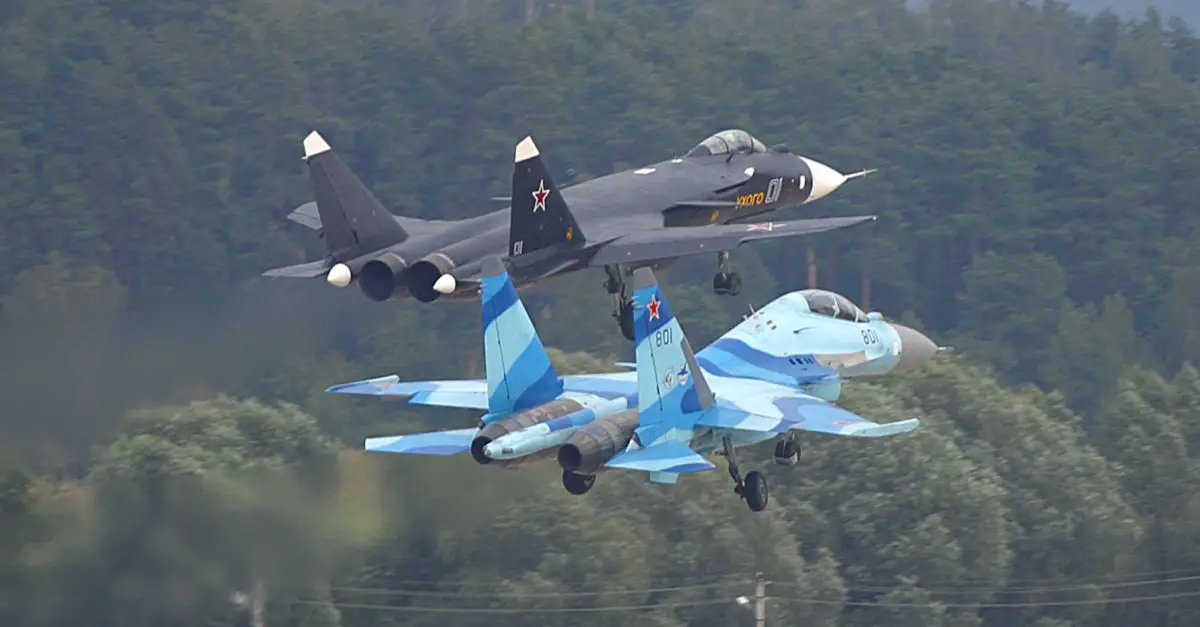Breaking News
Su-47, Russian experimental aircraft with Forward-Swept Wings that aspired to be unique, in vain.
The Russian Su-47 is a unique experimental aircraft known for its forward-swept wings, a design rarely seen in aviation. Introduced in 1997, the distinctive wing configuration of the Su-47 offers several advantages, including a higher lift-to-drag ratio, better maneuverability, and improved stability at high angles of attack.
Follow Army Recognition on Google News at this link

Su-47 next to a Sukhoi Su-35UB at the MAKS-2003 air show. (Picture source: Yevgeny Pashnin)
While some have described the fighter as stealthy, this relatively stealthy aircraft has become a hotly debated topic in the aviation world. The Russian Su-47 is one of the most distinctive and easily recognizable aircraft in the world. The reason? Its forward-swept wings. While almost all other aircraft in the world have either straight wings like the A-10 Warthog, delta wings like the Dassault Rafale, or rearward-swept wings like all the commercial aircraft you've ever flown, the wings of the Su-47 tilt forward, making the warplane impossible to miss. Indeed, the wing configuration of the Su-47 is rare: no forward-swept wing model has ever been mass-produced.
Forward-Swept Wings Were Experimental Before the Su-47
In the mid-20th century, a few aircraft designers experimented with forward-swept wings. The Nazis briefly experimented with a multi-engine bomber, the Junkers Ju 287, equipped with forward-swept wings. Convair proposed a supersonic bomber, the XB-53, with forward-swept wings, but the aircraft was never built.
Forward-swept versions of the Bell X-1, Douglas D-558, and North American P-51 Mustang were all proposed. At the time, however, the materials needed to make a forward-swept wing strong and rigid enough to support flight—without being too heavy—simply weren't available. Forward-swept wings need to be stronger than traditional wing configurations due to the aeroelastic behavior of forward-swept wings; they twist upward during flight.
As a result, these forward-swept fighter proposals were all abandoned at the design stage. Japan had some success with a forward-swept fighter during World War II, the Nakajima Ki-43. Yet, the forward sweep of the Ki-43 was minimal, barely noticeable, though technically present.
After the war, with improvements in material science, aircraft designers continued to experiment with forward-swept wing aircraft. Using newly developed carbon fibers, which were strong but lightweight, Cessna designed the NGP prototype, CZAW built the Parrot, and Saab built the Safari. More importantly, Grumman built an experimental jet, the X-29, with aggressively forward-swept wings.
Only two X-29s were built, but it was an exceptional aircraft, capable of maintaining control at an angle of attack of 67 degrees.
Finally, in 1997, Russia unveiled its Su-47 at the Paris Air Show. Like the Grumman X-29, the forward sweep of the Su-47 is aggressive. In other respects, however, the aircraft is ordinary. The forward fuselage, vertical stabilizers, and landing gear were all directly borrowed from the Su-27. With canard wings, the Su-47 is extremely maneuverable.
Although experimental flights and tests demonstrate it, the Su-47 proved some of the advantages of forward-swept wing configuration: higher lift-to-drag ratio; improved stall resistance; enhanced stability at high angles of attack; anti-spin characteristics; lower minimum flight speed; shorter takeoff and landing distances; better agility in dogfights.
In addition to its peculiar appearance, the Su-47 has high-end specifications. The Su-47 has a maximum speed of Mach 2.21 and a range of 2,100 miles. The jet can operate at a service ceiling of 59,000 feet and can withstand 9 g. With a climb rate of 45,900 feet per minute, the Su-47 can really ascend.
Only one Su-47 was built, and it was never armed. The aircraft has always impressed at air shows, demonstrating its remarkable wing shape and impressive agility. The knowledge gleaned from the Su-47 program was applied to the development of Russia's 4.5-generation fighter, the Su-35, as well as the fifth-generation Su-57. And the Su-47 seems to have a spiritual successor; in 2015, Russia unveiled the KB SAT SR-10, a single-engine training aircraft equipped with forward-swept wings. However, the SR-10 is a much more modest aircraft than the Su-47.

X-69 made by USA was presented 13 years before SU-47 and was a development failure ( Picture source : CNN )


























